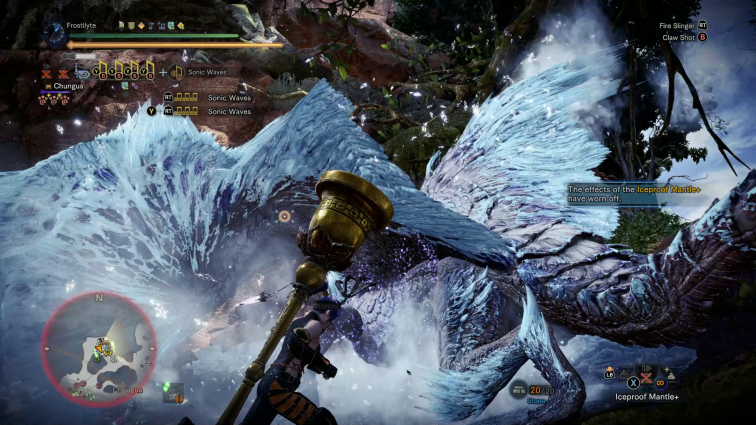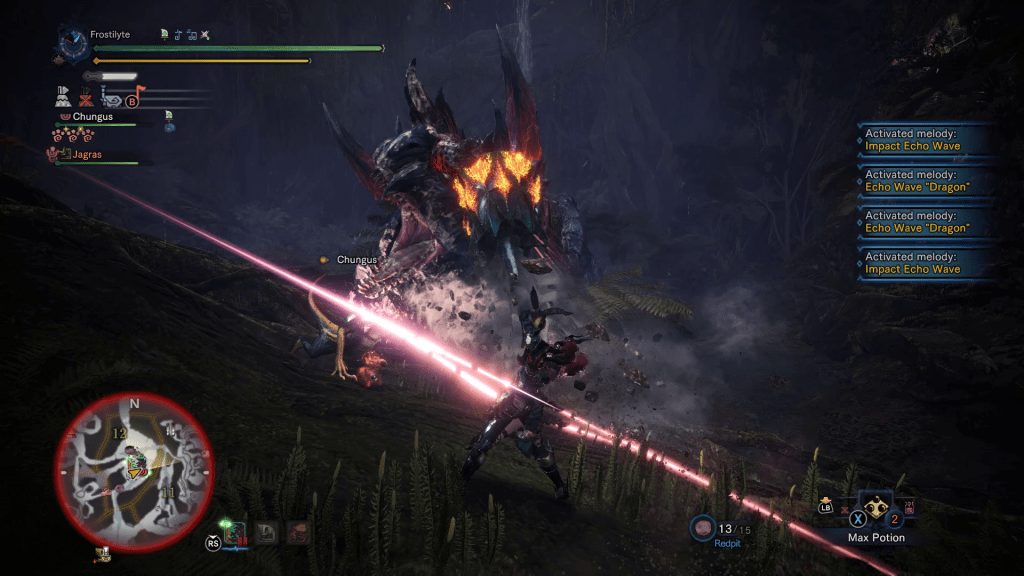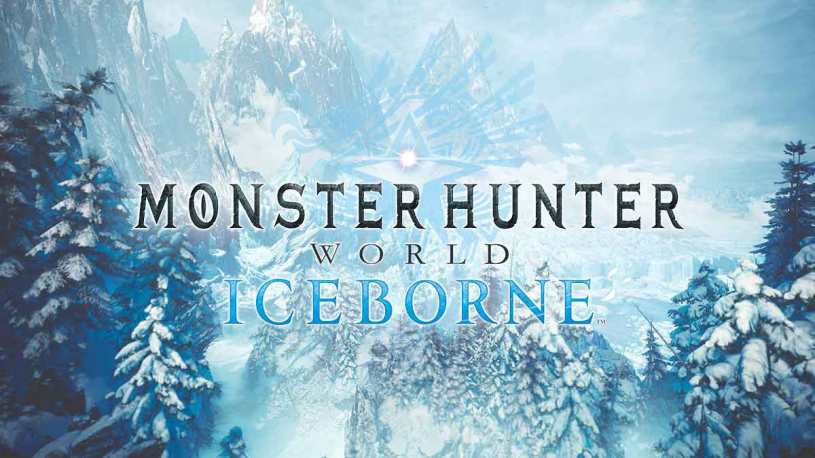For a very long time now I’ve struggled to articulate exactly why I didn’t enjoy Monster Hunter World’s Iceborne expansion as much as the base game. Only now, a year later, after playing the Monster Hunter Rise demo have I finally figured out what words to use to explain why I had such a drop off in enjoyment. With that said, let’s get into why I think Iceborne is a bit of a wet fart.
Firstly, we need to talk about the Clutch Claw. This isn’t the first time I’ve mentioned it, but here’s a refresher.

The Clutch Claw is a new mechanic that was introduced into Iceborne. It allows you to grapple onto a monster after which you can perform one of two actions. The first action is tenderizing. This performs a short combo that weakens the area you attacked so that it will be more susceptible to damage. Secondly, if you are on the monster’s head you can perform a flinch shot which will cause them to rush forward. If the monster collides with another monster, or the environment it will topple over which provides a huge opening to deal lots of damage.
At first glance the Clutch Claw seems like a fantastic addition to an already brilliant game. With careful timing and positioning you can increase the damage you do to a monster by weakening their hide and create your own burst damage opportunities. Or, that would be the case were it not for how poorly implemented the mechanic is.
The Clutch Claw Feels Unresponsive
The biggest problem with the Clutch Claw stems from how it feels. Game feel is one of those nebulous nuanced things that is often challenging to articulate because it isn’t tangible. When it comes to game feel players usually find that a game feels more responsive if there is a short time between when a button is pressed and when the associated action starts on screen. The longer a game takes to respond the cluckier it will feel. Generally speaking, fast feels good.
Monster Hunter World fits into a bit of a middle ground with regard to responsiveness. Generally speaking the actions are performed quickly after the player presses a button. The animations, however, tend to be very exaggerated and thus are on the slower side relative to other action games. Because of this, World lands in a murky middle ground where it feels somewhat responsive, but also a little clunky as you’re not able to quickly pivot from one animation to the next.

This weird middle ground of responsiveness makes the Clutch Claw feel terrible.
To use the Clutch Claw you must first aim it and then fire it off at your intended target. Similar to other action games, there is aim assist that will snap the targeting reticle to the nearest applicable target. It will then highlight the reticle bright orange to inform the player they are locked on and ready to fire. They can then press the fire button to send the claw out, grapple onto the monster and perform whichever follow-up option they deem most appropriate.
Unfortunately, the reticle glowing doesn’t mean shit. If the target moves between the button press and the claw reaching its destination than it fails. This creates a huge disconnect between what the player is told will happen and what actually happens. The result leads to the Clutch Claw feeling unresponsive as it’s too slow to complete the action that the game indicated was possible.

Where I aimed 
Where I landed
Further, along with the Claw not connecting, sometimes it will connect to something you weren’t targeting. If another available target crosses into the path of the claw it will connect to that instead of your intended target. Given the size of the monsters and the speed at which they move this is all too common of an occurrence that further reinforces the visual disconnect between the player’s expectations and the results.
The Clutch Claw Interrupts Flow
The other major problem with the Clutch Claw is that it interrupts flow. When I refer to flow I am referring to what is commonly called flow state. This is a psychology term for describing when someone is mentally immersed in what they’re doing. Video games are great at letting us hit flow state and most good action games will allow players to enter flow once they come to understand the different mechanisms and systems of said game.
Monster Hunter is no exception to this. After spending hours hunting monsters you’ll know all of your weapon combos and where they function best. You won’t think about how to use them, you’ll simply act. Likewise, you’ll recognize all of the tells from the monster and you’ll dance around its attacks while delivering your own decisive strikes.

The Clutch Claw constantly interrupts flow though.
In an absolutely baffling move almost none of the weapons were given new attacks that utilize the Clutch Claw. Instead, players must stop what they’re doing and pull out the claw to use it. This completely breaks the flow of combat and further reinforces the clunky feeling of the Claw. What’s worse is that you have a very powerful incentive for actually wanting to use the Clutch Claw. Both the tenderizing mechanic and flinch shot are extremely powerful when you can make use of them, so it’s a shame that you have to come to a complete stop to do so.
What Rise Does Different
It was only apparent to me that the unresponsive feeling of the Clutch Claw in tandem with how it interrupts flow is so core to why it feels bad to use after I played the Rise demo. In Rise the Clutch Claw has been replaced with a new mechanic called the Wirebug. Like the Clutch Claw, the Wirebug fires out a tether which can be followed up by a combo attack. The tenderizing and flinch shot mechanics aren’t present and instead the Wirebug provides a greater focus on mobility by allowing players to aggressively reposition in the middle of a fight. Here’s how it succeeds where the Clutch Claw fails.
Firstly, the Wirebug never shows a reticle, so players need to get a feel for how far it will reach. This eliminates the visual disconnect of being told something will work only to have it fail. Furthermore, even if you miss your intended target you’ll still perform the action as opposed to the Clutch Claw failing and leaving you doing nothing. By always performing a follow-through action, the Wirebug feels especially responsive.

Secondly, each weapon has their own unique Wirebug techniques, which can be chained into normal weapon combos. Instead of having to come to a complete stop you’re able to organically weave the Wirebug into your combat flow. By integrating the Wirebug thoughtfully into each of the weapon’s move-sets, the developers have allowed it to act as a natural part of the player’s gameplay.
The Clutch Claw is such a clunky and problematic addition to World and the game was only made worse for it. Fights that once flowed elegantly can only continue to do so if players entirely ignore the Clutch Claw though, particularly in the end game, Capcom made engaging with it almost mandatory. It’s for this reason that Iceborne soured my opinion of World.
I don’t think it is any coincidence that the Wirebug feels like a vastly improved implementation of the Clutch Claw. With the release of Rise on the horizon I believe the Monster Hunter team took it upon themselves to iterate on their failed experiment by refining all of its rough edges to deliver a much more polished version of the kind of experience the Clutch Claw was intended for. It’s unfortunate that none of this polish will be applied retroactively into World, but hopefully the Clutch Claw, as it exists now, will remain a relic of the past never to be seen again.

I’m really hoping for a PC release of Rise not too long after the Switch’s. The controls of rise — even with a Switch Pro controller — felt awful to me. I probably would’ve eventually acclimated to it but it was enough to tip me over the edge to just waiting for PC release again when I had been hyped enough otherwise to break with tradition and buy the console version first even when I believed a PC version imminent.
In any case — on Iceborne; agree the clutch-claw was an awful addition, but for slightly different reasons.
I hate it solely for the tenderise mechanic. *Ugh*.
I can handle the fact that a lit reticule doesn’t really mean anything given the movement of the monsters. I can handle the interruption of flow for flinch shots because the reward for executing one feels significant enough to be worth that time spent.
But tenderise… I didn’t mind it when Iceborne came out. I just took it for what it was and worked with it.
Only after recently returning have I cast a more critical eye on it. It just isn’t fun. It ignores the learnings of games gone before that mandatory short term buffs that can be (and so need to be) maintained 100% of the time just aren’t any fun.
Every 90 seconds or so, you need to break flow — as you mentioned already — and tenderise otherwise you’re quite significantly disadvantaged on damage output. So it’s a punitive response for not doing it, rather than feeling like a buff when you do.
…
…God I hope Rise comes to PC before too long… 😉
LikeLiked by 1 person
For brevity sake I focused in on my main sticking points, but I 100% agree with you here.
There’s also how a subset of the weapons have to use a tenderizing combo twice to start tenderizing and re-tenderize before the duration is up so that they only have to do a single combo to maintain it instead of having to do ANOTHER two combos. By and large I feel as though tenderizing only really works in a group setting. There I find it reaps greater benefit and by having the tenderizing duties split between four people it’s a lot less tedious.
There’s also the whole thing where flinch shots have a detection problem where monsters can slide along walls instead of bonking into them, but, again, I wanted to keep on my main points lol.
Anyway, here’s hoping. And if Rise skips over PC (and the other consoles) here’s hoping a Monster Hunter World 2 (or something) hits PC before long. 😛
LikeLike